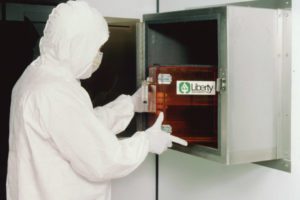5 Facts You Should Know About Cleanroom Filtration
Leave a Comment
Since 1953, Liberty Industries has been creating high quality cleanrooms, cleanroom filtration systems, and contamination control supplies. We have more than 65 years of experience designing and building customized cleanrooms for use in a diverse range of industries by customers around the world.
The filtration system is a critical component of any cleanroom. Well-designed cleanrooms require air filters that control air flow, remove particles from the room, and keep external pollutants out to prevent contamination of manufacturing processes, critical research or other projects.
The Facts About Cleanroom Filtration
Understanding the basics about cleanroom filtration can help to avoid contamination and ensure that the cleanroom is functioning at an optimal level. Here are five important facts:
1. There are three types of air filters.
- Pre-filters. These filters pre-remove larger particles from the air before the it reaches more comprehensive HEPA or ULPA filters, extending the lifespan of the more expensive filters.
- HEPA filters. High-Efficiency Particulate Air (HEPA) filters are the most commonly used filter, with capabilities to filter particles of 0.3µm or larger. Depending on the application, HEPA filters can last more than seven years before replacement is required in many applications. Based on specific cleanroom protocol, filters may have to be changed more often.
- ULPA filters. Ultra Low Particulate Air (ULPA) filters are similar to HEPA filters, though they are capable of removing 99.999% of contaminants larger than 0.12µm. This capability to remove smaller particles makes ULPA filters the most expensive filter type.
2. Particles may be filtered in numerous ways due to a filter’s design
Depending on the design of the filter, there are four different ways particles may be filtered.
- Straining/sieving. This filtering method catches any particles that are larger than the clearance between the fibers of the filter.
- Inertial/impaction. The inertia of the particles forces them out of the airstream, where they get stuck to adhesive fibers.
- Interception. Smaller particles get caught in the airstream and are carried towards the filter fiber, which then intercepts them before they can be released back into the air.
- Diffusion. Perfect for very small particles, diffusion bombards contaminant particles with air molecules until they go into vibration mode. This vibration makes it much easier for filter fibers to catch even the smallest particles, although it has little impact on larger ones.
3. HEPA filters are the most commonly employed filter in cleanrooms.
HEPA filters were first invented in 1941 to protect scientists from Alpha particles created as they developed the atomic bomb. They are made from pleated layers of media paper, in which particles then get trapped. Filters must remove a minimum of 99.97% of particles before they can be designated as HEPA.
4. Filter maintenance should be performed regularly depending on the filter.
Since filters for cleanrooms can be used 24/7, they may deteriorate faster than other types of equipment. On average, pre-filters should be replaced six times a year and HEPA filters should be replaced every three years. However, factors such as cleanroom location, nearby construction, and air pollution can impact these maintenance schedules.
5. People are the biggest risk to proper cleanroom filtration.
While filters keep air filtered, humans pose the biggest risk to cleanroom filtration. It is the responsibility of the employee to reduce the risk of contamination and ensure that the air is being properly filtered. Proper clothing such as gowns, coveralls, gloves, face masks, and goggles can help prevent contamination from employees. Cleanrooms may also incorporate sinks, showers, and other disinfection equipment in entry and/or exit areas for applications with very high cleanliness standards.
Filtration Products Available at Liberty Industries
We offer a wide range of quality filtration products to suit every need. Some of our most popular products include:
- HEPA/ULPA filters. Our filters are engineered to meet ISO 14644-1.
- Pre-filters. These non-woven, fine-fibered media pre-filters allow you to upgrade preexisting systems easily.
- Charcoal filters. Charcoal filters used primarily for odor reduction.
Work With Liberty Industries
Implementing a high-quality filtration system is vital to the functionality of any cleanroom. To learn more about how our experts can help you design or optimize your cleanroom, contact us or request a quote today.
The Advantages of Cleanroom Pass-Thrus
Leave a Comment
Since 1953, Liberty Industries has served as a global manufacturer and distributor of high-quality cleanroom and contamination control supplies and accessories. We offer a broad selection of cleanroom products, ranging from modular, softwall and hardwall cleanrooms to cleanroom components to personnel garments. Regardless of your cleanroom needs, our experienced engineers can design and deliver a custom-tailored solution that meets your specifications.
Cleanrooms are generally used in the manufacture of sensitive components that cannot tolerate contamination—e.g., medical devices, pharmaceuticals, and electronics. These structures provide control over the workspace, maintaining set levels of temperature, humidity, light, air pressure, and other environmental variables. They can also have additional features, such as sealed airlocks and decontamination areas, that facilitate the maintenance of sterile conditions.
Pass-thrus—also known as pass-thru cabinets, chambers, or windows—are a critical cleanroom component. These two-door structures are typically installed directly into the cleanroom’s walls and, when opened one door at a time, allow objects to pass into or out of the cleanroom while reducing the risk of contaminants.
What Are the Benefits of Pass Thrus for Cleanrooms?
Pass-thrus are an affordable and easy-to-install way to protect the cleanroom environment and meet industry safety standards. In addition to preventing external contaminants from entering the cleanroom, they reduce the number of workers in the room at any given time and limit the frequency of room entries and exits. Both of these things help to further reduce the risk of contamination.
Integrating a pass-thru also means cleanroom personnel do not need to shower and gown up to place or remove materials from the cleanroom. This saves time and, ultimately can increase productivity.
Pass-thrus are durable, easy to clean and maintain. Additionally, they are highly customizable, coming in a range of materials, sizes, and designs to meet different cleanroom needs. For example, they are available with fireproofing for combustible material handling and with HEPA air filters for highly sensitive product manufacturing.
The integration of pass-thrus benefits virtually any industry that requires the use of cleanrooms, including the following:
- Aerospace
- Computer manufacturing
- Electronics and technology
- Medical
- Military
- Pharmaceuticals
- Research
- Solar power generation
Types of Pass-Thrus Available at Liberty Industries
At Liberty Industries, we offer several pass-thru models for cleanroom construction projects, including:
- Stainless steel pass-thru. Also known as a pass-thru window communicator or package transfer unit, this pass-thru system features stainless steel construction, acrylic doors, and stainless steel hinges. Customization options include interlock systems, fireproof doors, and custom sizes.
- H-100SS pass-thru with a magnetic lock. This two-door cabinet uses a magnetic interlock system to keep both doors from opening at the same time. It is especially useful for hospital pharmacies and other organizations that require high levels of security.
- H-100 PL series laminated pass-thru.This pass-thru chamber is made with high-pressure plastic laminate and has an acrylic door with chrome-plated hinges. It provides maximum protection from contamination while still allowing for the easy transfer of materials. Optional add-ons include a reverse-action interlock.
- Motorized HEPA/ULPA-filtered pass-thru. This pass-thru unit has a high-velocity air wash and highly efficient filter. Custom sizes and filtration levels are available, as well as options for stainless steel shelves, laminated novaply, and fireproof doors. Customers can choose from recirculating or non-recirculating models.
Partner With Liberty Industries for Your Cleanroom Needs
Pass-thrus are critical cleanroom components that help keep your cleanroom contaminant-free for sensitive manufacturing operations. With over 65 years of experience designing and constructing cleanrooms, the Liberty Industries team can help you choose the right model and design to suit your cleanroom needs.
For additional information about pass-thrus or to discuss your cleanroom specifications with one of our experts, contact us or request a quote today.
Positive Air Pressure Cleanrooms vs. Negative Air Pressure Cleanrooms
Leave a Comment
As a manufacturer and distributor of top-of-the-line cleanrooms and contamination control products, Liberty Industries, Inc. serves as a one-stop shop for all cleanroom needs. Our expert team assists in every aspect of cleanroom creation—from design to construction and assembly—to provide custom-tailored solutions to a wide range of industries. Whether a customer requires a standard or highly specialized area; a positive air pressure cleanroom or negative air pressure cleanroom, we can meet their needs.
Positive Pressure vs. Negative Pressure Cleanrooms: Similarities and Differences
When planning or preparing for a cleanroom installation, one of the most significant design considerations is whether it features a positive air pressure or a negative air pressure configuration. This factor relies heavily on the specifications of the intended application.
Positive Air Pressure Cleanrooms
A positive air pressure cleanroom has an air pressure level that is greater than that of the surrounding environment. This is achieved through the use of an HVAC system, which pumps clean, filtered air into the structure. When the door of the cleanroom is opened or if the cleanroom experiences a structural breach, the pressure disparity forces the clean air out rather than allowing unfiltered, potentially contaminated air in.
Positive air pressure cleanrooms are most commonly used in applications where keeping contaminants—such as dirt or debris—away from the contents of the cleanroom is critical. For example, it can be used to protect immunocompromised patients in hospitals or sensitive products such as microchips during the manufacturing process.
Negative Air Pressure Cleanrooms
In contrast to a positive air pressure cleanroom, a negative air pressure cleanroom maintains an air pressure level that is lower than that of the surrounding room. This condition is achieved through the use of an HVAC system that continuously filters air out of the room, pumping clean air into the room near the floor and sucking it back out near the ceiling.
Negative air pressure cleanrooms are used to keep contaminants contained within the enclosed work environment. If opened or breached, the pressure disparity forces air into the cleanroom, preventing contaminants from escaping. For the room to function properly, all windows and doors must be fully sealed and outtake filters must be installed.
This type of cleanroom commonly finds application in the biochemical, pharmaceutical, or medical industries. Industry professionals use it as an isolation chamber when testing or working with potentially harmful compounds and separating contagious patients to help prevent the spread of illness.
Similarities Between Positive Pressure and Negative Pressure Cleanrooms
Although the functions of positive pressure and negative pressure cleanrooms are quite different, they are some similarities between the two. For example, both types require the use of:
- Powerful HEPA filters, which, along with the other HVAC system parts, need careful maintenance
- Self-closing doors and properly sealed windows, walls, ceilings, and floors to facilitate the maintenance of appropriate air pressure levels
- Multiple air changes per hour to ensure proper air quality and pressure conditions
- Ante-rooms for employees to change into the required protective clothing and deliver the necessary materials and equipment
- In-line pressure monitoring systems
Leave it to the Experts at Liberty Industries to Design & Construct Your Cleanroom!
Whether you need a positive air pressure or negative air pressure cleanroom, an experienced cleanroom manufacturer and distributor, such as Liberty industries, can ensure the design, development, and delivery of a solution that meets your needs. At Liberty Industries, our experts have full working knowledge of the entire cleanroom design and construction process, from cleanroom materials and best practices to the HVAC equipment needed for different types of applications. We also offer a variety of cleanroom accessories and equipment, including shoe brush machines, Tacky Mats ® and air showers.
No matter what type of cleanroom you need, we’re your one-stop shop to getting the perfect solution. For additional information about our cleanroom capabilities or to discuss your cleanroom specifications with one of our experts, contact us or request a quote today.


